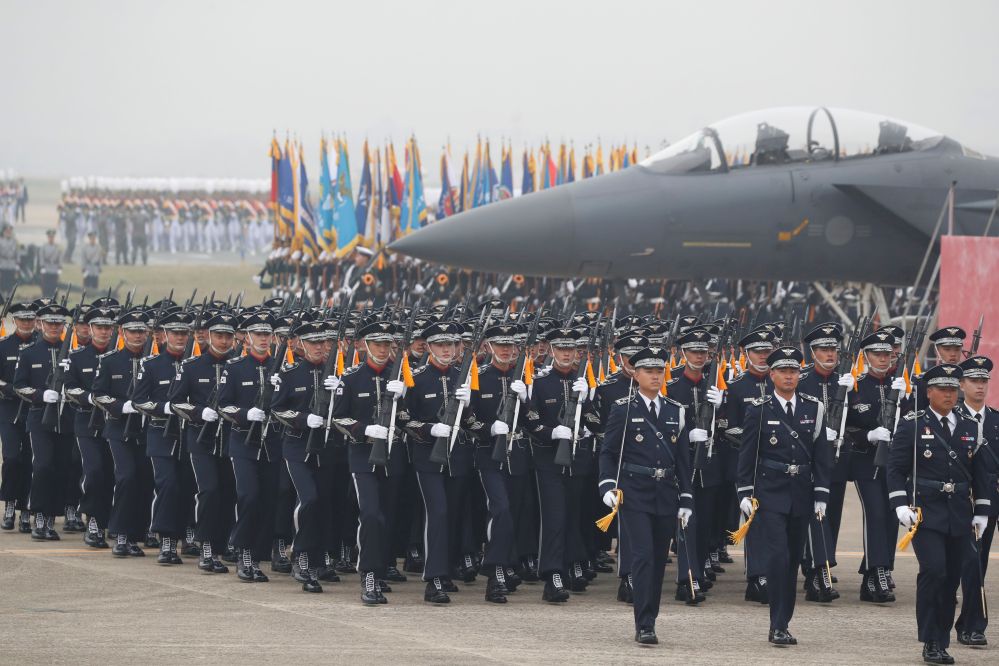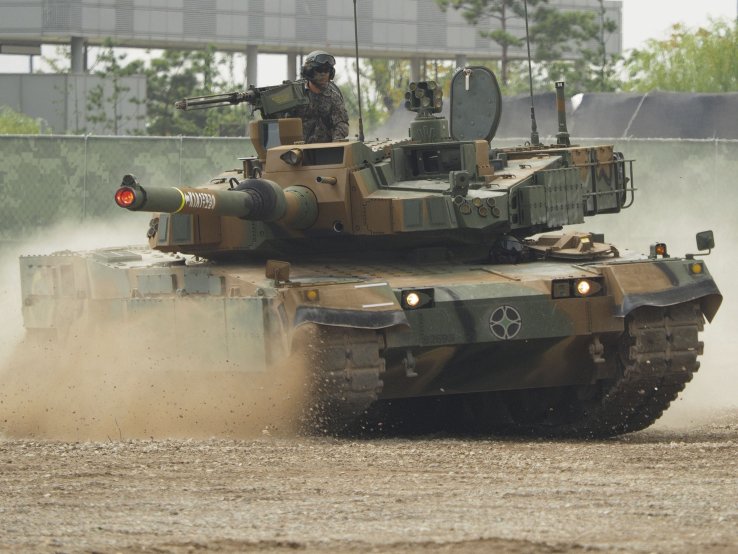The military is turning its focus to domestic research and development and seeking to become a major arms supplier, and that is scaring North Korea.
BY MORTEN SOENDERGAARD LARSEN | NOVEMBER 1, 2019, 9:51 AM
SEOUL—The air itself shook as a pair of F-15K Slam Eagle fighter jets roared a few meters above the ground to celebrate South Korea’s 71st annual Armed Forces Day in Daegu last month. Behind the massed military array, a series of photos of missile-launching vehicles, high-tech fighter jets, and other materiel appeared on a big screen.
Until now, most of those weapons have been U.S.-made. But South Korean officials expect a more even balance on future Armed Forces Days as they increase their own weapons production in the face of the threat from North Korea and Washington’s uncertain stewardship of stability and peace in East Asia. And, in the long run, those weapons are going to be exported around the world, said Daniel Pinkston, a lecturer in international relations at Troy University based in Seoul.
“South Korean defense firms have wanted to increase their exports for some time,” he said.
The South Korean National Defense Ministry’s latest budget is set to increase by 7 percent yearly, which means that the country is going to spend around $240 billion on defense from 2020 to 2024. And a sizable chunk of that money, $85 billion, is going to “arms improvement.”
“With the uncertainty regarding the current national security environment, the government has increased the budget to strengthen the national defense and to help the military take counterpart action in omnidirectional security threat,” the ministry told Foreign Policy in a statement. “To ensure the self-reliance of national defense and to lead to development of scientific technology, the acquisition policies were changed from foreign purchases to domestic R&D and to support domestic defense industry.”
Analysts say South Korea has other frustrations with its old ally the United States, the world’s biggest weapons exporter. For one, U.S. defense companies don’t share the latest developments without demanding a huge payout from South Korea to help cover their research and development costs. The Trump administration is also reportedly demanding an almost fivefold increase in South Korea’s contribution to the cost of basing around 28,500 American troops in the country.
Until recently, the alliance between South Korea and the United States has been famously considered “ironclad,” but the latest move by President Donald Trump to withdraw forces from northeastern Syria, prompting a military advance by Turkey into Kurdish-held territory, has also caused waves in South Korea. Trump has also repeatedly questioned the deployment of U.S. troops and bases elsewhere around the world.
“It certainly sends a message to South Korea regarding cost-sharing talks: past loyalty means nothing,” Jeffrey Robertson, an expert in South Korean diplomacy at Seoul’s Yonsei University, told Voice of America in a recent report.
Nothing has been confirmed as the cost-sharing negotiations over U.S. troops are entering their second round of talks behind closed doors, but South Korean media have been reporting on the price hike for months. In a recent interview with the local Dong-a Ilbo newspaper, U.S. Ambassador to South Korea Harry Harris said Seoul contributed only one-fifth of the total defense cost and should take on a larger share.
In an editorial in one of South Korea’s largest newspapers, the Chosun Ilbo, the decision to pull out of Syria was lamented as a betrayal of the Kurds and “the main reason for the betrayal was money.” The editorial also pointed out that Trump appears to see the U.S.-Korea alliance as based on money and he has repeatedly talked about pulling out over the costs.
For now South Korea is still shopping American, and most recently they announced the purchase of 20 new F-35 fighter jets with vertical takeoff capabilities for $3.3 billion. But the frustration with needing to pay up in order to catch up has helped push forward the idea of South Korea’s military becoming more self-reliant, according to Pinkston.
“The South Koreans would like to reduce import dependency for advanced military technologies,” he said. “Since the 1970s, South Korea gradually has moved up the technology ladder to produce more complex systems, but they are still dependent on foreign sources for the most advanced technologies.”
The gradual move toward more self-dependency since the 1970s has made South Korea’s military tech fairly competitive compared with other nations of its size—a trend that has been helped along by the constant presence of an existential threat to the north.
“Have you seen the cruise missiles? We call them ‘North Korean foreign-policy missiles,’” a local journalist said during Armed Forces Day, which took place on Oct. 1, with a laugh. Four missiles stood proudly presented next to the air force’s newest arrival, the F-35A stealth fighter jet.
One of South Korea’s most recent domestic defense projects is the KAI KF-X multirole fighter jet, developed jointly with Indonesia but spearheaded by Korea, which holds 80 percent of shares in the project. The production of the jet has recently entered its second phase, and Korea expects to roll out the first prototype in 2021.
North Korea is plainly worried about the increased military spending, especially as Kim Jong Un’s efforts at reconciliation—first with South Korean President Moon Jae-in and then with Trump—have appeared to flag. This summer, several sets of missiles were routinely launched from North Korea as a message and warning to South Korea’s “double dealings”—because, in the eyes of Pyongyang, South Koreans talk of peace and negotiations with one face and acquire fresh attack capabilities with the other.
There is also an economic incentive for the South Korean government’s military expansion. South Korea is an export-driven economy, and the government seeks to help businesses with great export potential. In times of trouble, defense solutions are a sought-after commodity. And these are times of trouble.
China and Japan are also increasing military spending, and Russia has started flying patrols jointly with China, most recently flying over an island claimed by South Korea, which prompted warning shots and a small diplomatic crisis.
“There is a lot of uncertainty in the region and the world now, so South Korea and other countries are acquiring more defense capabilities as they hedge against possible instability or threats in the future,” Pinkston said.

Tired of U.S. Dependence, South Korea Seeks to Build—and Sell—Its Own Weapons
The military is turning its focus to domestic research and development and seeking to become a major arms supplier, and that is scaring North Korea.



